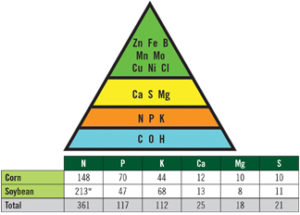
Back to Basics: Fertilizer and Macronutrients
It can be very difficult to keep all of the inputs used for crop production organized. To help keep ourselves straight we often lump fertilizer into one broad category without taking in to account the variation in importance and role that a nutrient has in the plant. In the illustration on the right you can see how the different elements are broken out visually into a pyramid. Non-Fertilizer elements come first and are supplied solely from the environment: carbon, hydrogen and oxygen. After them come fertilizer elements broken into three groups – primary macro-nutrients, secondary macro-nutrients, and micro-nutrients. Primary macro-nutrients are nitrogen, phosphorus, and potassium while calcium, sulfur, and magnesium are considered secondary macro-nutrients. Macro-nutrients are required in large amounts and should be the primary and secondary focus of a fertilizer plan, respectively. They form the base of the nutrient pyramid of crop production. They can be weak points in yield if not corrected before adding micro-nutrients, which are needed in far smaller amounts for adequate yields. Below the pyramid to the right, you can see the crop removal rates for both corn and soybeans. These rates are in lbs of nutrient (not product) and are just for grain removal, no stover. It is important to make sure plants get enough of these important building blocks as they are used in a variety of ways.
- Nitrogen is an important part of chlorophyll and plant proteins.
- Phosphorus plays a large role in energy transfer inside plant cells.
- Potassium is key to stomate activity (structures that take in carbon dioxide and realize oxygen after photosynthesis)and is also an important component in plant cell structure and strength.
- Calcium is critical for cell wall formation.
- Magnesium is another component of chlorophyll.
- Sulfur is crucial for photosynthesis and nitrogen utilization.
